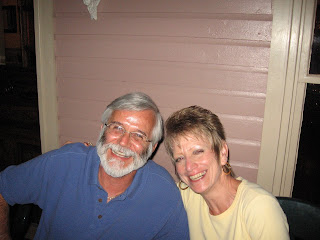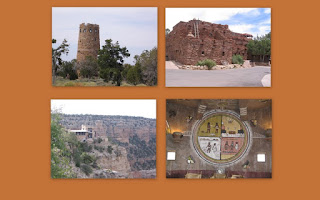 Condors
Condors Sunset over the canyon
Sunset over the canyon Looking at the North Rim.
Looking at the North Rim. The Colorado River
The Colorado River The river gorge.
The river gorge. Jim & Nanc on the edge.
Jim & Nanc on the edge. South Kaibab Trail
South Kaibab Trail Bright Angel Trail
Bright Angel TrailLookout Studio, Inside Watchtower
Now that we have shown you all these pictures you need to read this quote by C. O. Hall, an 1895 visitor who describes the Grand Canyon perfectly. "No language can fully describe, no artist paint the beauty, grandeur, immensity, and sublimity of this most wonderful production of Nature's great architect. [Grand Canyon] must be seen to be appreciated."
We are now staying at Trailer Village in Grand Canyon National Park. Don't you think the park service could come up with a more appropriate name for their RV campgrounds than Trailer Village, the same name they use in Big Bend? In another comparison to Big Bend, the Grand Canyon has more "bars" both on the cell phone and in the many lodges and restaurants. That said, this place is fantastic beyond description. We walked to the rim upon arrival and were completely blown away by the sight of the canyon. It is hard to believe as you look down into it that the Colorado River carved this massive canyon out of the solid rock. It must have been unbelievable for those first people who discovered the canyon. As you approach from the south across the Colorado Plateau there is nothing to indicate that you are going to come to this 277 mile long, 10 mile wide, one mile deep scar in the earth. It is so large that it's impossible to comprehend the scale. We went over the rim and hiked the South Kaibab Trail and after two hours and 2000 feet down we decided to turn around realizing we were not even half way to the bottom and it was going to be a steep climb on the return. On another day we hiked a portion of the flat Rim Trail which runs along the edge for 12 miles. This is a great way to see the canyon because a shuttle bus runs parallel to the trail so you can go as far as you like in one direction and then return on the bus. It is also paved, except for a very small portion, which makes it easy for walking. We also hiked three miles and 2100 feet down into the canyon on the very popular Bright Angel Trail. Even though it was steeper, we liked the South Kaibab Trail the best since it runs out along a ridge and gives much better views of the canyon. The views of the canyon are spectacular and ever changing as the shadows and light 0f the sun moved. We can't put into words how fantastic this place is and we hope the pictures will help, but realize that they only capture a small portion of this vast expanse. You have to see it to experience the real beauty of this incredible place. One rule to remember here is what goes down must come up. If you decide to hike down there is no alternative but to walk back to the top. It also gets hotter the lower you hike into the canyon with the temperature being 80 degrees at the point where we turned around and in the 60's when we returned to the top. This would be a real factor in the summer when it can be 80 degrees at the top and 100 degrees at the bottom.
We are now staying at Trailer Village in Grand Canyon National Park. Don't you think the park service could come up with a more appropriate name for their RV campgrounds than Trailer Village, the same name they use in Big Bend? In another comparison to Big Bend, the Grand Canyon has more "bars" both on the cell phone and in the many lodges and restaurants. That said, this place is fantastic beyond description. We walked to the rim upon arrival and were completely blown away by the sight of the canyon. It is hard to believe as you look down into it that the Colorado River carved this massive canyon out of the solid rock. It must have been unbelievable for those first people who discovered the canyon. As you approach from the south across the Colorado Plateau there is nothing to indicate that you are going to come to this 277 mile long, 10 mile wide, one mile deep scar in the earth. It is so large that it's impossible to comprehend the scale. We went over the rim and hiked the South Kaibab Trail and after two hours and 2000 feet down we decided to turn around realizing we were not even half way to the bottom and it was going to be a steep climb on the return. On another day we hiked a portion of the flat Rim Trail which runs along the edge for 12 miles. This is a great way to see the canyon because a shuttle bus runs parallel to the trail so you can go as far as you like in one direction and then return on the bus. It is also paved, except for a very small portion, which makes it easy for walking. We also hiked three miles and 2100 feet down into the canyon on the very popular Bright Angel Trail. Even though it was steeper, we liked the South Kaibab Trail the best since it runs out along a ridge and gives much better views of the canyon. The views of the canyon are spectacular and ever changing as the shadows and light 0f the sun moved. We can't put into words how fantastic this place is and we hope the pictures will help, but realize that they only capture a small portion of this vast expanse. You have to see it to experience the real beauty of this incredible place. One rule to remember here is what goes down must come up. If you decide to hike down there is no alternative but to walk back to the top. It also gets hotter the lower you hike into the canyon with the temperature being 80 degrees at the point where we turned around and in the 60's when we returned to the top. This would be a real factor in the summer when it can be 80 degrees at the top and 100 degrees at the bottom.
We were also lucky enough to see several California Condors soaring in the canyon. These giant birds with 9-foot wingspans are still on the edge of extinction with only about 170 surviving in the wild at this time. One afternoon we watched as 8 to 10 condors took turns roosting in trees and on the canyon walls, then gliding on the air currents in the canyon below. While these birds are really ugly up close, they are beautiful and graceful as they sail through the sky. Other wildlife we saw included birds, deer, elk, lizards, and squirrels, most of which are very used to people thus giving really up close views.
Many of the lodges and buildings in the park are historical landmarks that were built a hundred or more years ago for the first tourists. Mary Colter, an architect for Fred Harvey the original concessionaire, designed most of these older structures with native materials that naturally blends into the surroundings. She designed a fireplace in the Bright Angel Lodge that creates a geological model of the canyon by using stones from the different levels, bottom to top, in its construction. One evening we went to dinner in the lounge of the historic El Tovar Lodge and had an interesting encounter. As we stood looking for a table, two ladies asked us to join them. We said, "You must be from Europe because most Americans would not offer to share their table." From their small act of kindness we had a wonderful evening with Marie from France and Lolita from Spain. We talked about everything from traveling to politics and thoroughly enjoyed the evening. These kinds of experiences are just another great part of being on the road.
Here is another little story our RVing friends will relate to. We have seen literally hundreds of rental RVs on the road in the west, especially in the national parks, and we are always a bit concerned when we see one approaching on the narrow park roads. One day on the shuttle bus the driver actually stopped upon seeing a rental coming down the road and announced, "I would rather face a rattlesnake than a rental RV." While we have yet to encounter a rattler, we do know what he means.
This has been a spectacular visit but our one and only disappointment was that we did not get to hike to the bottom and stay at Phantom Ranch. We learned you have to make reservations at least a year in advance to get a room at the bottom. We look at that as a reason to return and experience this wonderful place again in the future.













































